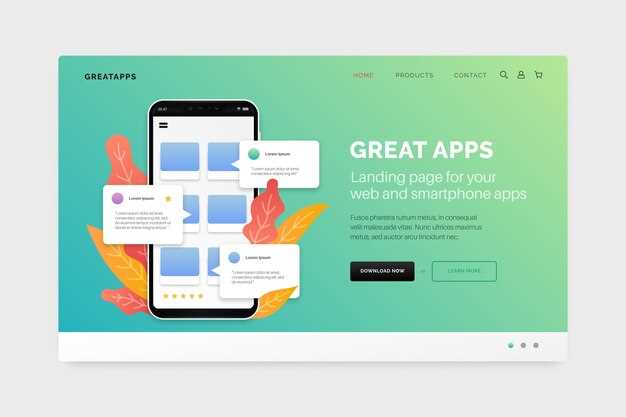In an era dominated by handheld gadgets, creating seamless interactions is essential. Users demand fluidity and beauty in their digital journeys. Striking the right chord can lead to loyalty and satisfaction. But what happens when the same content must adapt to an array of displays?
Every device tells a story, and that narrative hinges on how information is presented. The relationship between form and function is critical, influencing how individuals engage with their screens. It’s about ensuring that regardless of the size, the essence of the experience remains intact. This challenge often becomes a balancing act, requiring innovation and insight.
As fluctuations in dimensions occur, designers must embrace versatility, ensuring that aesthetics complement practicality. They need to pivot on the feedback received from users in real time. Furthermore, this exploration opens doors to creative methodologies that enrich potential solutions. In this landscape, understanding the nuances of visual hierarchy becomes foundational.
Whether it’s a compact phone or a robust tablet, the goal remains clear: provide clarity without compromise. The success of any approach lies in its ability to engage and retain attention. Through a lens of empathy and adaptability, builders of digital realms can redefine how interactions are perceived.
Mastering User Experience in Mobile App Design

Creating a compelling interface is essential for engaging users effectively. The interaction between a user and their device should feel natural and seamless. Each touchpoint is an opportunity to leave a positive impression. This consideration extends beyond mere aesthetics; functionality plays a critical role.
Every user seeks efficiency and clarity. They deserve environments tailored to their unique needs. Hence, intuitive navigation and logical structures are paramount. Failure to address these areas can lead to frustration, ultimately driving individuals away from your creation. When designing, one must contemplate how individuals interact with technology–physically and cognitively.
As various devices present distinct challenges–screen dimensions, resolutions, and input methods–designers must remain adaptable and resourceful. A well-constructed solution accommodates users, ensuring access to necessary features without overwhelming them or complicating interactions unnecessarily.
Research indicates that simpler layouts yield higher satisfaction levels. By focusing on essential functionalities, you not only guide users effortlessly, but also enhance their overall perception of the product. Regular feedback is invaluable; it informs adjustments that keep the experience relevant.
In essence, your goal should always center around delighting those who engage with your offering. Anticipate their requirements and modify accordingly for maximum effectiveness. The journey may be intricate, yet with the right approach, it leads to creating truly user-focused solutions.
Understanding Screen Size Optimization

In today’s digital landscape, tailoring interfaces for diverse dimensions is crucial. Each device brings its unique attributes, influencing how users interact with content. Adaptability ensures that functionality remains intact without losing visual appeal. Whether you’re working on a large tablet or a compact gadget, optimizing for various dimensions enhances accessibility. This should be at the forefront of any visual project.
Why does this matter? Different users have distinct needs and preferences. A seamless transition between devices can significantly boost engagement and satisfaction. The way an image is displayed on a smartphone may not work effectively on a larger screen. Thus, understanding the nuances of layout and interactivity is essential.
- Recognize varying pixel densities.
- Consider the orientation, whether landscape or portrait.
- Evaluate touch targets for accessibility.
- Prioritize readability and navigation ease.
The overall goal is to create an interface that feels right at any size, allowing users to enjoy consistent interaction. Ultimately, successful adaptation is about balancing aesthetic appeal with functional purpose. It requires conscious thought into layout, typography, and even the spacing of elements. Meticulous attention to detail in these areas can significantly elevate the user’s journey, making each interaction feel intuitive and fluid.
- Start with a flexible grid system.
- Use responsive images that adjust based on display dimensions.
- Implement scalable vector graphics to maintain quality.
- Conduct extensive testing on real devices to gather feedback.
This iterative approach not only improves usability but also fosters a sense of familiarity, which is often the key to retention. By integrating these strategies, designers can create cohesive environments that resonate with audiences across various formats. Each method contributes to a holistic understanding of the project, prioritizing user satisfaction and engagement throughout.
The Importance of Screen Size in Design
The dimensions of a display hold immense significance in the realm of creation. They influence how content is perceived and interacted with. With varying measurements, the same visuals can convey entirely different feelings. Small screens bring intimacy, while larger ones evoke openness. Understanding these nuances is essential.
Each format demands tailored approaches to ensure optimal functionality. Consider how a simple button might look on a compact device versus an expansive monitor. Elements can appear cramped or overly spacious based on their environment. Furthermore, recognizing this diversity allows for strategic placement of features.
When crafting interfaces, one must prioritize adaptability to fluctuations in size. A seamless transition from one format to another can enhance engagement dramatically. Simplicity combined with thoughtful arrangement enhances clarity, promoting ease of navigation. It’s crucial to align functionality with aesthetic appeal across all platforms. Poorly optimized elements can lead to frustration and disengagement.
The depth of customization required for various dimensions can be daunting, yet it is rewarding. It provides an opportunity to innovate and experiment. Ultimately, appreciating the implications of these variations can lead to transformative experiences for all users, ensuring they feel valued and understood regardless of their chosen device.
Techniques for Effective Layout Adjustment
Creating a visually pleasing and functional interface requires careful consideration of various factors. Each device presents unique challenges and opportunities. Therefore, it is essential to adapt structures dynamically. Flexible arrangements can enhance accessibility and ensure a seamless interaction. Users appreciate when their needs are anticipated.
One method involves utilizing responsive grids. These grids adjust according to the dimensions of the displaying device, allowing elements to rearrange fluidly. By employing a grid system, designers can ensure that information is presented in an organized manner. This approach minimizes clutter and confusion.
Another effective strategy is utilizing breakpoints strategically. Adjusting the layout at specific widths helps maintain visual integrity across formats. Breakpoints serve as pivotal moments where significant changes occur. Such adjustments can include resizing images, modifying text placement, or altering navigation. These thoughtful transitions can drastically improve usability.
Incorporating adaptive elements is yet another technique worth considering. Elements that change based on context can provide a richer interaction. For instance, toggle features may offer simplified views based on the user’s current needs. Context-aware layouts can also lead to better performance, as they respond reactively to different situations.
Lastly, testing across a variety of devices remains crucial. Feedback from real users highlights strengths and weaknesses in your approach. Conducting usability studies often reveals insights that may not be initially apparent. Continuous iteration informed by user behavior leads to refinement and optimization in layout versatility.
Common Pitfalls to Avoid
Creating an effective interface for various devices can be challenging. Many developers stumble into the same traps. They often overlook crucial aspects of usability. Inexperience leads to frustration for users. Certain approaches may seem appealing but can backfire.
A serious mistake is ignoring how different resolutions impact appearance. Each device has unique characteristics that dictate how content is presented. Without thorough testing, elements can appear misaligned or overly cramped. This can diminish the appeal and functionality.
Another frequent error is overloading the interface with too much information. Users need clarity, not chaos. When screens get cluttered, important features can be lost. A streamlined approach will always enhance visibility and comprehension.
Designing solely for high-resolution screens is misleading. Pathways to accessibility often get obstructed otherwise. Failing to take into account older devices can alienate a significant portion of the audience. By ignoring these users, potential engagement reduces dramatically.
Lastly, neglecting the importance of touch interactions can lead to disastrous results. Buttons and links need to be appropriately sized for easy access. Users should never struggle to tap a vital function. When touch targets are too small or too close, frustration precedes satisfaction.
Testing Across Multiple Devices
In today’s fast-paced digital landscape, ensuring consistent performance on various platforms is crucial. Different gadgets offer unique challenges and opportunities. Each device comes with its own features and limitations. Hence, the necessity to simulate real-world usage scenarios becomes paramount.
The value of thorough evaluations cannot be overstated. Understanding how a product behaves on diverse interfaces is essential for success. A thorough examination can unveil hidden issues that might otherwise go unnoticed. By taking a proactive approach to assessment, developers can refine their offerings, making them more reliable and appealing to users.
To effectively approach cross-device testing, one should first identify key variations among gadgets. This includes screen resolution, hardware capabilities, and operating systems. Consider the following aspects:
| Aspect | Considerations |
|---|---|
| Screen Resolution | Design must adapt fluidly to different pixel densities. |
| Hardware | Performance can vary based on CPU, RAM, and storage. |
| OS Variability | Different systems might render interfaces unpredictably. |
| User Interaction | Touch, swipe, and click functionalities vary significantly. |
Testing should not be an afterthought; it should be woven into the development lifecycle. Allocate resources and time for meticulous evaluations. Techniques such as automated testing and real-time feedback can complement traditional testing methods. When done right, the process of validating functionality across various devices leads to increased satisfaction and loyalty.
Strategies for Responsive and Adaptive Design
Creating interfaces that smoothly transition between devices is essential. It’s not just about adjusting layouts. It’s about engaging users in a seamless journey. The challenge lies in addressing the uniqueness of each platform. A thoughtful approach guarantees that content remains accessible and visually appealing.
Firstly, understanding the diversity of device capabilities is crucial. Different resolutions and pixel densities can significantly impact how your creation is perceived. Implementing flexible grids helps maintain a dynamic flow of information. By utilizing fluid layouts, elements can resize according to the viewport. This adaptability ensures that interaction remains intuitive.
Secondly, the application of media queries allows for targeted styling. Designers can define specific breakpoints that better fit distinct screen types. This technique enables tailored adjustments and fosters optimal viewing conditions. As devices become increasingly varied, precise control over styles becomes imperative.
Additionally, prioritizing content hierarchy is vital. Users should always see the most critical information first. This encourages effective navigation and minimizes cognitive load. By using responsive typography and scalable images, one can maintain aesthetic integrity while enhancing readability.
Finally, continuous testing across multiple devices cannot be overstated. Frequent evaluations reveal how different environments influence performance. Gathering feedback can lead to meaningful improvements and optimizations. As the digital landscape evolves, remaining agile and ready to adapt ensures prolonged success. Being proactive in design strategies will help you thrive in a competitive market. Balancing functionality and aesthetics should always drive your creative process.
Responsive Design Basics and Benefits
Creating interfaces that adapt seamlessly to various devices is crucial. It fosters engagement and retains interest. Such flexibility caters to users’ needs effectively. Essentially, it helps maintain consistency and usability.
In today’s diverse technology landscape, where smartphones, tablets, and desktops dominate, it’s vital to ensure optimal viewing experiences. Whether someone is scrolling on a small device or navigating on a large screen, well-crafted frameworks adjust accordingly.
This methodology is rooted in the principle of fluidity, where layouts respond to the dimensions of the screen. It involves using dynamic grids and adaptable images. Such approaches enhance accessibility and navigation for everyone.
The advantages are numerous. First, it reduces maintenance costs, as there’s no need for multiple versions of the same content. Additionally, it boosts search engine rankings, enhancing visibility across platforms. When users encounter a site that adjusts to their preferences, it builds trust and encourages repeat visits.
Moreover, embracing this approach means staying ahead in a competitive environment. Companies that prioritize spatial adaptability position themselves as forward-thinking. This not only ensures satisfaction but also encourages innovation.
Adaptive Techniques for Unique User Needs
Every individual interacts with technology in their unique way. Creating interfaces that cater to various preferences and abilities is crucial. Flexibility and personalization can significantly enhance accessibility. This approach promotes inclusivity and empowers every user to engage meaningfully.
Understanding diverse requirements is not just important; it’s essential. Different users have varied motivations and backgrounds. They utilize devices for distinct purposes. Consequently, solutions must adapt dynamically to these varying contexts.
- Conduct thorough research on target demographics.
- Implement customizable themes for visual preferences.
- Provide alternative navigation methods, such as voice commands.
- Allow users to adjust content size for better readability.
- Incorporate feedback mechanisms for continuous improvement.
By leveraging these strategies, developers can create environments that support each individual’s journey, thus fostering a deeper connection between technology and its users.
It’s not just about functionality but also about solving specific challenges faced by many. Simple variations, like color schemes or layouts, can greatly impact usability. When addressing the needs of diverse groups, empathy plays a vital role. Offering users choices empowers them and enhances their engagement significantly.
Incorporating analytics to evaluate usage patterns can inform future adaptations. This helps in identifying areas for improvement, ensuring that solutions remain relevant and effective over time. Regular updates driven by real-world usage further cement user trust and satisfaction.
The ultimate goal remains clear: cultivate an adaptable ecosystem that acknowledges and celebrates individuality.
Designing for Cross-Device Functionality
Creating digital products that function seamlessly on various devices is essential. As technology evolves, users expect a fluid interaction. They switch between devices without a hitch. Adaptability should be at the forefront of every developer’s mind. Users desire consistency, no matter what hardware they are using.
Ensuring that features are accessible regardless of the platform is crucial. This can be achieved by focusing on a cohesive navigation system. Maintain the same structural elements to provide familiarity, allowing users to feel at ease. For instance, if a feature is prominent on one device, it should be equally prominent on another. Employing responsive frameworks can assist designers in achieving this level of uniformity.
Moreover, consider how touch interactions differ from mouse clicks. Ensure that buttons are appropriately sized for ease of use, regardless of input method. Also, contextual menus might work seamlessly on one device type but could become cumbersome on another. Therefore, thoughtful adjustments are essential to ensure usability remains intuitive.
Compatibility testing must not be overlooked. Continuous iterations based on user feedback will highlight areas needing attention. By analyzing how individuals engage with their devices, crucial insights can be gained. A responsive approach is not just about making things fit; it’s about understanding how users interact with content.
Ultimately, the goal is not just functionality, but creating an enjoyable digital journey. This requires careful planning and foresight. The more comprehensive the understanding of diverse device capabilities, the smoother the navigation will become. Reinventing the wheel shouldn’t be necessary, but refining existing concepts can lead to remarkable outcomes.
Video:
I Built An App UI/UX Design Using ONLY AI! (In 30 Minutes) 🤖💻 | Saptarshi Prakash
I Built An App UI/UX Design Using ONLY AI! (In 30 Minutes) 🤖💻 | Saptarshi Prakash by Saptarshi Prakash 42,018 views 2 months ago 28 minutes
Q&A:
Why is it important to consider different screen sizes in mobile app design?
Considering different screen sizes in mobile app design is crucial for ensuring a consistent and user-friendly experience. With a variety of devices available, including smartphones and tablets, users expect apps to be optimized for their specific screen dimensions. Ignoring this can lead to layout issues, inaccessible features, and a frustrating experience that may drive users away. By focusing on different screen sizes, designers can enhance usability, improve engagement, and ultimately increase the app’s success and retention rates.
What are some best practices for designing mobile apps for various screen sizes?
Some best practices for designing mobile apps across different screen sizes include using responsive design techniques, setting flexible layouts, and utilizing scalable assets. Responsive design allows the app’s interface to automatically adjust to the screen size, ensuring a seamless experience. Additionally, using relative units like percentages for widths and heights helps maintain proportionate layouts on various devices. It’s also beneficial to test designs on multiple devices during the development process to identify potential issues and iterate on designs for optimal performance and user satisfaction.
How do user interface (UI) elements change with different screen sizes?
User interface (UI) elements often need to be adjusted based on screen sizes to maintain usability and aesthetics. On smaller screens, elements may need to be larger and more spaced out to accommodate touch gestures, while larger screens can afford to include more complex navigation and multi-column layouts. For instance, buttons on smaller screens should be easily tappable, whereas on larger screens, additional information and options can be displayed without overwhelming the user. Managing the hierarchy of elements is also crucial; consolidating less important features on smaller devices while showcasing essential functions prominently can enhance user experience.
What role does user testing play in designing for different screen sizes?
User testing is vital in the design process for mobile applications, especially when catering to different screen sizes. By involving real users in testing scenarios, designers can observe firsthand how users interact with the app across various devices. This helps identify usability challenges, interface confusion, and areas needing improvement. Collecting feedback allows designers to make informed adjustments to enhance user experience, ensuring that the app functions well regardless of the device being used. Ultimately, user testing ensures that designs are user-centered, resulting in a more intuitive and satisfying app experience.
Can frameworks and tools help with designing for multiple screen sizes, and if so, which ones are recommended?
Yes, various frameworks and tools can significantly assist designers in creating apps that function well across multiple screen sizes. Frameworks such as Bootstrap and Foundation offer responsive grid systems that simplify layout adjustments. Additionally, tools like Figma and Adobe XD allow designers to create and prototype designs for different devices, facilitating testing and iteration. These tools often come with features that enable visibility across various screen sizes, ensuring that the user interface is effective and visually appealing on all devices. Utilizing such resources can streamline the design process and enhance overall quality.




